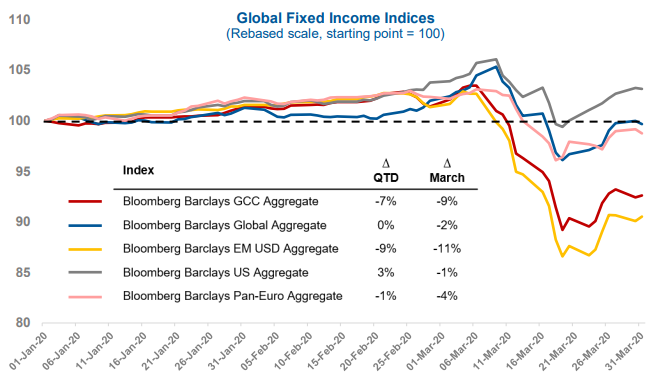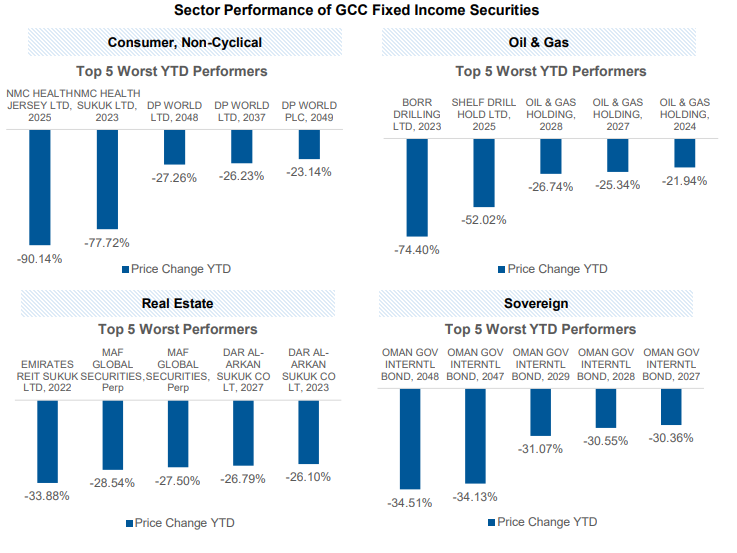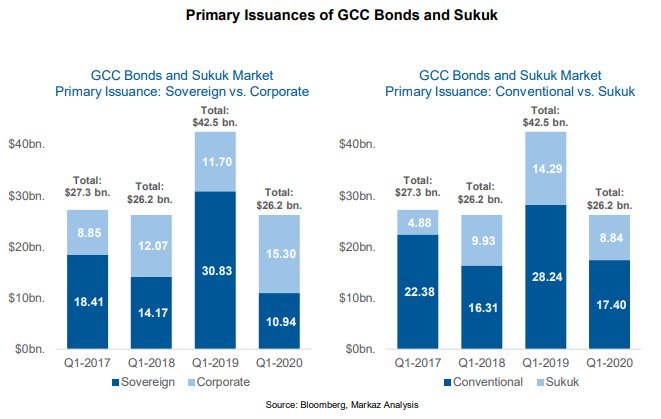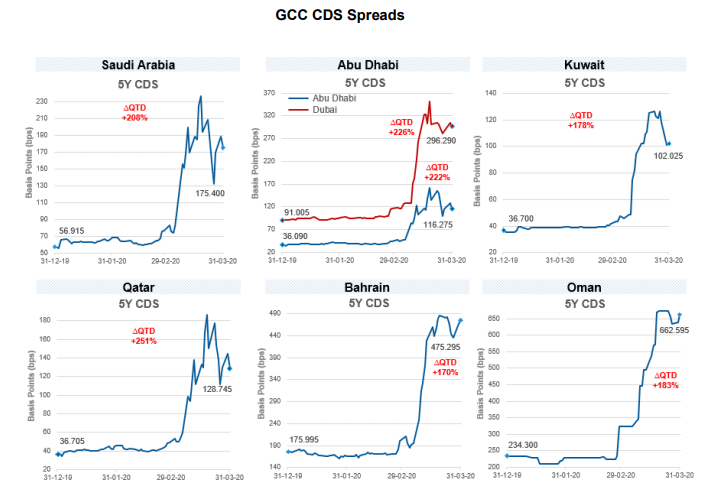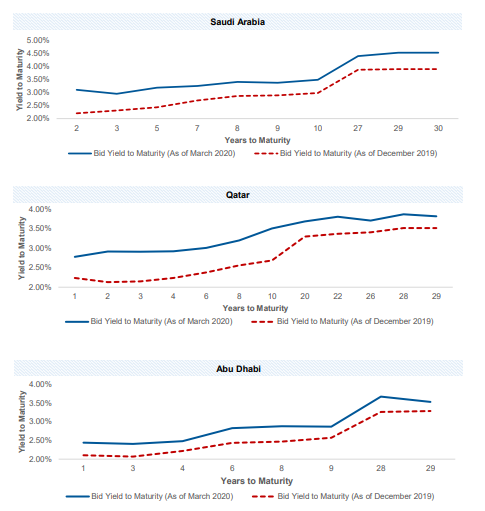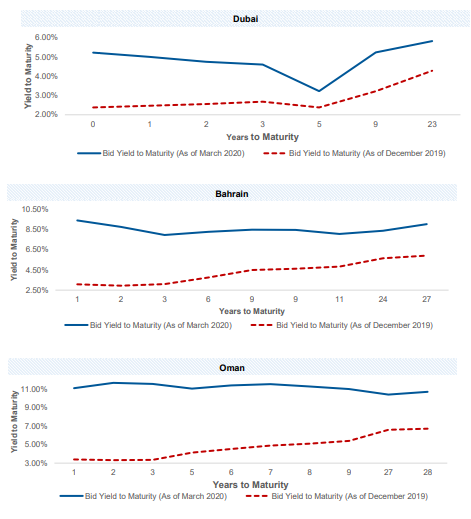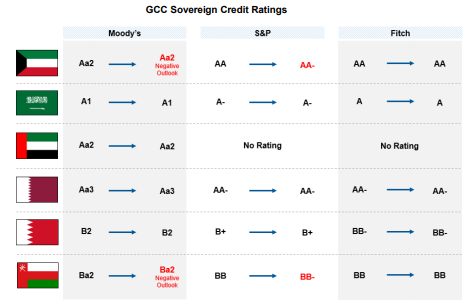
Kuwait Financial Centre “Markaz”, in its GCC Fixed Income research report for the first quarter of 2020, has highlighted the implications of the outbreak of COVID-19 on fixed income markets in the region. The report notes that the outbreak of the disease has significantly impacted global financial markets across all asset classes, pushing central banks and policymakers to intervene and provide wide-ranging economic stimulus measures in the face of worsening economic conditions. Within the global fixed income markets, the global pandemic event has resulted in elevated volatility and widened spreads. Aside from the pandemic, global markets witnessed a sharp drop in oil prices during March as well, placing further strain on oil-dependent economies, translatinginto further pressure on regional fixed income markets.
The implications of the pandemic on regional fixed income markets weremanifold. Regional fixed income indices were down for the first quarter of the year, whereas key sectors in the GCC experienced large sell-offs of Bonds and Sukuk and elevated spreads. Primary issuances of Bonds and Sukuk in the GCC witnessed weak activity in March as a result of the uncertainty surrounding the pandemic, leading to a meagre quarter of primary debt issuances in 2020 in comparison with previous quarters. Moreover, Credit Default Swap (CDS) spreads, a measure largely regarded as an indicator of default for sovereign countries, spiked across all GCC countries during March. Finally, the pandemic event and the sharp decline in oil prices pushed credit rating agencies to downgrade both Kuwait and Oman on 31 March, citing deteriorating global economic outlook and falling oil prices.
Performance of Fixed Income Indices
Initially, majorleading global fixed income indices were up by the end of February, before witnessing sharp declines in March and wiping any gains for the year subsequent to the declaration of COVID-19 a pandemic by the World Health Organization (WHO). By the end of February 2020, the Bloomberg Barclays Global Aggregate was up 2%.Similarly, the Bloomberg Barclays GCC Aggregate, an index representative of fixed income securities of the 6 countries that form the Gulf Cooperation Council, was up 1%.Moreover, the Bloomberg Barclays Emerging Markets Aggregate was up 1%, whereas the Bloomberg Barclays US Aggregate and Pan-European Aggregate indices were up 4% and 2%, respectively. However, during March, the Bloomberg Barclays Global Aggregate fell by 2%, therefore ending the first quarter of the year at 0% return. In comparison, the Bloomberg Barclays GCC Aggregate was down by 9% ending the first three months of the year at a loss of 7%, while the worst-performing index was the Bloomberg Barclays Emerging Markets Aggregate index which lost 11% in March, to end the first quarter of the year with a total loss of 9%. The Bloomberg Barclays US Aggregate index is the only index up for the year, posting a return of +3% for the quarter, whereas the Bloomberg Barclays Pan-European Aggregate lost 4% in March, recording a loss of 1% for the first quarter of the year.
Sector Performance of GCC Fixed Income Securities
With few exceptions, all GCC bonds and Sukuk across sectors were negatively impacted as a result of the disruption caused by the coronavirus outbreak and the sharp drop in oil prices, a major source of revenue for the GCC countries. Among these, high yielding bonds and longer maturities witnessed the biggest decline in each sector; however, Consumer (Non-Cyclical), Oil and Gas, Real Estate and low rated Government bonds experienced the brunt of the impact. NMC Healthcare, based in the UAE, experienced the steepest decline in its 2025 bond and saw prices fall by 90.14% in the first quarter of the year as reports of fraudulent financial reporting emerged indicating inflated asset purchases and capital expenditures as well as understated debt.Borr Drilling witnessed the sharpest decline in the Oil and Gas industry as its 2023 bond witnessed a 74.4% decline in valueduring Q1 2020. The Emirates REIT witnessed the sharpest decline year-to-date in the Real Estate Industry as the value of its 2022 bond declined by 33.9%. Among GCC Sovereign bonds, Oman experienced the greatest decline in prices across different maturities as low oil prices are expected to strain the country’s fiscal budget. As of Q1 2020,Oman’s 2027 bond declined by30.36%, 2029 bond declined by 31.07% and 2048 bond declined by 34.51%.
Primary Issuances of GCC Bonds and Sukuk
During March 2020, the total primary issuances of Bonds and Sukuk in the GCC amounted to USD 5.4 billion, representing a decline of 75% from the total primary issuances of USD 21.5 billion achieved in March 2019. The decline in primary issuances represents a 4-year low and is largely as a result of the uncertainty surrounding the global pandemic event. During Q1-2020, primary issuances of Bonds and Sukuk in the GCC amounted to USD 26.2 billion, compared to USD 42.5 billion during the same period in 2019. This represents a decrease of 38% year-on-year.
Moreover, primary issuances by Sovereign GCC entities decreased by 65% year-on-year to reach USD 10.94 billion during Q1-2020, compared to USD 30.83 billion in Q1-2019. On the other hand, primary issuances by Corporate entities in the GCC increased by 31% year-on-year to reach USD 15.30 billion during Q1-2020, compared to USD 11.70 billion during the first quarter of 2019. However, the majority of Corporate issuances in the GCC during 2020 came in January and February, prior to declaring COVID-19 as a pandemic.
GCC CDS Spreads
In March 2020, the 5-year CDS spreads have increased for all GCC countries reflecting a perception of higher credit for these countries. The halting of the global economy and the projected fall in future oil revenues are seen as adding further strain on the budgets of GCC governments, thus increasing the perceived risk of default. During March, Qatar saw its 5-year CDS spreads change from 49.010 bps to 128.745 bps, Abu Dhabi from 44.690 bps to 116.275 bps, and Dubai from 116.070 bps to 296.290 bps.Kuwait’s 5-year CDS spread was priced at 41.735 bps at the beginning of March, which increased to reach 102.025 bps. Saudi Arabia’s 5-year CDS spread was priced at 76.535 bps and increased to reach 175.400 bps at the end of the month. Moreover, Bahrain saw its 5-year CDS spreads increase from 201.195 bps to 475.295 bps during March, whereas Oman’s 5-year CDS increased by from 324.585 bps to 662.595 bps during the same period.
GCC Yield Curve
Bond prices have an inverse relationship with yields; as bond prices increase, yields decrease and vice versa.During Q1 2020, GCC sovereign curves shifted upwards in line with the added risk of the economic shutdowns posed by COVID–19 and fiscal budgetary pressures of low oil prices, indicating higher cost of funding for these countries Saudi Arabia saw the yield on its2025 bond widen by 75 bps to 3.19% during Q1 2020, and the 2050 bond widen by 64 bps to 4.54%. Similarly, Qatar saw the yield on its2026 bond widen by 63 bps to 3.01% and the yield on the 2049 bond widen by 30 bps to 3.81%.Furthermore, the 2026 Abu Dhabi bond widened by 39 bps to 2.83% and the 2049 bond widened by 24 bps to 3.52%. Dubai saw its 2025 Dubai Sukukwiden by 85 bps to 3.23% and the 2043 Dubai bond widen by 154 bps to 5.83%. Bahrain and Oman experienced heightened volatility in terms of yield spreads as the yield on the 2026 Bahrain bond widened by 452 bps to 8.26% and the yield on 2047 Bahrain bond widened by 311 bps to 9.02%. As for Oman, the yield on its2025 bond widened by 691 bps to 11.06% while the yield on the 2048 bond widened by 398 bps to 10.70% indicatingmarkets are perceiving higher risks of defaults amid increasing economic turbulence. Kuwait’s only outstanding bonds maturing in2022 and 2027 widened by 3 bps and 26 bps as of Q1 2020, respectively. A comprehensive yield curve cannot be established for Kuwait due to the lack of government issuances.
GCC Sovereign Credit Ratings
One of the more important implications of the outbreak of COVID-19 and decline in oil prices is the S&P’s downgrade of Kuwait from AA to AA- with a stable outlook and Oman from BB to BB- with a negative outlook. Moreover, Moody’s changed its outlook for both countries from Stable Outlook to Negative Outlook and has placed both countries on review for a potential downgrade. Fitch, however, affirmed Kuwait’s credit rating at AA and maintained a stable outlook for the GCC country.
